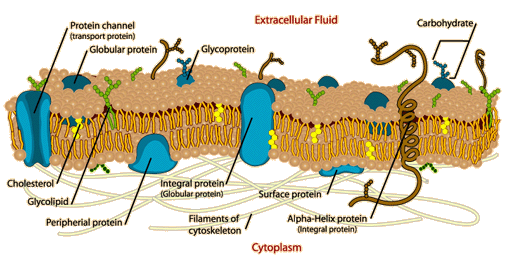The Cell Membrane
All living cells and many of the tiny organelles internal to cells are bounded by thin membranes. These membranes are composed primarily of phospholipids and proteins and are typically described as phospholipid bi-layers.
 | In this sketch, the spheres represent the phosphate end, which is polar and water soluble (hydrophilic). The twin extensions represent the fatty acid components which are not water soluble (hydrophobic). |

Cell membranes also contain cholesterol in the phospholipid bilayer. In some membranes there are only a few cholesterol molecules, but in others there are as many cholesterols as phospholipids according to Audesirk & Audesirk. Cholesterol makes the bilayer stronger, more flexible but less fluid, and less permeable to water-soluble substances such as ions and monosaccharides.
The above illustration of a cell membrane was modified from Wikipedia. It shows that the cell membrane contains much more than just the phospholipid bi-layer.
| Transport across cell membranes |
Reference
Audesirk & Audesirk
Ch 5
Enger & Ross
Ch 4
| HyperPhysics***** Biology | R Nave |
